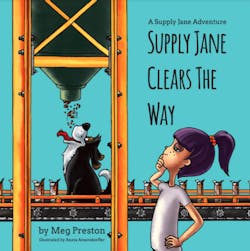Finding next-gen manufacturing and supply chain pros...in second grade
Author Megan Preston Meyer
If you poll the average second-grade classroom about their aspirations on Career Day, you’ll probably see a lot of raised hands for astronaut, marine biologist, professional athlete or veterinarian. Fewer for materials-planner or manufacturing-systems analyst.
Why is that? It’s not, in my (admittedly biased) opinion, that being an analyst is less intrinsically rewarding than being an astronaut—it’s that kids simply don’t know that jobs in manufacturing and supply chain are an option. I certainly didn’t, at least not in second grade. In fact, I didn’t even know what supply chains were until well after college, when I got a job optimizing them. Like a lot of people I’ve talked to, I didn’t seek out a career in supply chain—I stumbled into it.
Let’s take the stumbling blocks away for the next generation.
How? Well, the first step is building awareness. Kids need to see these careers—whether it’s from parents doing presentations at school, whether it’s a factory tour to see manufacturing in action, or whether it’s tracking a package from the retailer to the doorstep. And even more than that, they need to experience these jobs. Luckily, manufacturing and supply chain concepts are easy to make kid-friendly. They are concrete, real, and visible—if you know where to look.
A book from the "Supply Jane & Fifo Adventures" series
Your next trip to the grocery store can be an adventure. Drive around to the back and check out the loading docks: carrots and apples don’t grow in the store; they have to be brought in by truck. Check the expiration dates on the cheddar: why are the blocks in the front different than the blocks in the back? Discuss an empty shelf: what might have gone wrong to make your favorite brand of peanut butter unavailable?
Have conversations with your kids about the way things work and about the people who make them work. Expose them to media that celebrates “normal” people doing “normal-people” jobs. For every cartoon and book about an astronaut, throw in one that’s a little more down-to-earth.
We don’t have to go to galaxies far, far away to inspire kids; there’s enough to capture their imaginations right here at home. There are so many jobs within the manufacturing sector. The industry spans from super-high-tech to hand-crafted, and within each company there are all types of positions: engineering and assembly, HR and QC, marketing and data science and sales. As any kid who chooses Legos over Roblox can appreciate, at the end of the day, you’ve contributed to something tangible. Manufacturing can offer that; a lot of industries can’t.
We can get kids interested in manufacturing and supply chain. It’s going to take books and role models and conversations and cartoons. The competition is stiff for kids’ attention, but there are ways to capture their imaginations. If we keep showing kids that anything is possible, and show them a wide range of options, we’ll start seeing a few more hands raised for supply chain and manufacturing jobs at second-grade Career Day.
From there, the sky’s the limit. Maybe they do want to be an astronaut. Amazing! Let them shoot for the stars. Even if they miss, they might end up as an aerospace assembly technician.
Megan Preston Meyer is the author of the "Supply Jane & Fifo Adventures" series of children's books.





